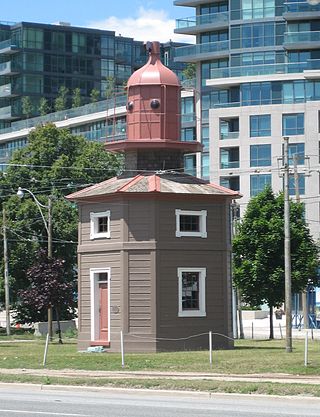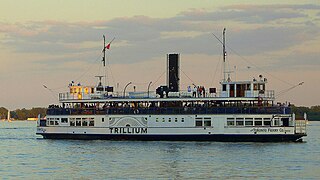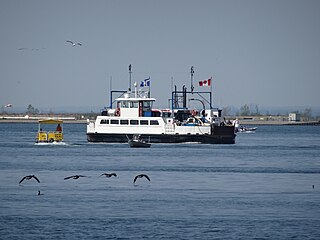
The Toronto Islands are a chain of 15 islands in Lake Ontario, south of mainland Toronto, Ontario, Canada. Comprising the only group of islands in the western part of Lake Ontario, the Toronto Islands are located just offshore from the city's downtown area, provide shelter for Toronto Harbour, and separate Toronto from the rest of Lake Ontario. The islands are home to the Toronto Island Park, the Billy Bishop Toronto City Airport, several private yacht clubs, a public marina, Centreville Amusement Park, a year-round residential neighbourhood, and several public beaches. The island community is the largest urban car-free community in North America. Public ferries operate year-round from Jack Layton Ferry Terminal, and privately operated water taxis operate from May to September. A pedestrian tunnel connects the mainland to the airport.

Billy Bishop Toronto City Airport is a regional airport located on the Toronto Islands in Toronto, Ontario, Canada. It is often referred to as Toronto Island Airport and was previously known as Port George VI Island Airport and Toronto City Centre Airport. The airport's name honours Billy Bishop, the Canadian World War I flying ace and World War II Air Marshal. It is used by civil aviation, air ambulances, and regional airlines using turboprop planes. In 2022, it was ranked Canada's ninth-busiest airport.

Toronto Harbour or Toronto Bay is a natural bay on the north shore of Lake Ontario, in Toronto, Ontario, Canada. Today, the harbour is used primarily for recreational boating, including personal vessels and pleasure boats providing scenic or party cruises. Ferries travel from docks on the mainland to the Islands, and cargo ships deliver aggregates and raw sugar to industries located in the harbour. Historically, the harbour has been used for military vessels, passenger traffic and cargo traffic. Waterfront uses include residential, recreational, cultural, commercial and industrial sites.

The Toronto Island ferries connect the Toronto Islands in Lake Ontario to the mainland of Toronto, Ontario, Canada. The main city-operated ferry services carry passengers (all) and commercial vehicles (some) from the Jack Layton Ferry Terminal at the foot of Bay Street to three docks on the islands. Private motor vehicles are not carried. The ferry operated by PortsToronto carries passengers and vehicles to Billy Bishop Toronto City Airport on the island from the foot of Eireann Quay. Additional private ferries carry passengers to various island boat clubs. Ferry services to the islands began in 1833, and the Toronto Island Ferry Company began in 1883.

The Toronto Ferry Company was formed from the merger of the Doty Ferry Company with A.J. Tymon's Island Ferry Company, two of Toronto's early ferry operators to Toronto Islands in 1890. TFC was founded and headed by businessman Lol Solman, who owned several attractions on the Toronto Islands including Hanlan's Point Amusement Park, Hanlan's Point Stadium and the Hanlan's Hotel. The company's ferry license and ships as well as the amusement park and other assets were acquired by the Toronto Transportation Commission in 1927. On March 17, 2021, The Toronto Ferry Company Inc was registered under the Ontario Business Corporations Act to Michael A. McLaughlin.

The Queen's Wharf Lighthouse is a lighthouse in Toronto, Ontario, Canada, situated at Fleet Street just east of the Princes' Gates at Exhibition Place. The octagonal building was originally one of a pair of lighthouses built in 1861 at Queen's Wharf, replacing an earlier 16-foot lighthouse built in 1838. The 11-metre (36-foot) three-storey wood structure is one of two surviving 19th-century lighthouses in Toronto.

The Dee Why and Curl Curl, were two identical steam ferries servicing Sydney Harbour's Circular Quay to Manly service. Both commissioned in 1928, they were the largest ferries on Sydney Harbour until the 1938 introduction of the South Steyne.

MV Queen of Surrey is a double-ended C-class roll-on/roll-off ferry in the BC Ferries fleet. The ship was launched in 1980 and entered service in 1981. The ferry normally operates on BC Ferries' Horseshoe Bay to Langdale route. She is named for the city of Surrey. On May 12, 2003, Queen of Surrey suffered an engine fire that disabled the ferry in Howe Sound. No one was injured and the ship was returned to service. In 2004, the ferry was involved in a collision with a tugboat, and in 2019 she struck a fixed structure at the Langdale terminal. The 2019 crash lead to passengers being stranded on the vessel for over ten hours.

William Lyon Mackenzie, is a fireboat operated by Toronto Fire Services (TFS) which provides marine fire fighting and icebreaking capabilities within the Toronto Harbour. Built by Russel Brothers in 1964, it is named after William Lyon Mackenzie, the first mayor of Toronto. In 2004 the fireboat was refurbished and it is expected to be in service until 2037.

MV Queen of Oak Bay is a double-ended C-class roll-on/roll-off ferry in the BC Ferries fleet, launched in 1981 at Victoria, British Columbia. The 139.29-metre (457 ft) long, 6,969-ton vessel has a capacity for 362 cars and over 1,500 passengers and crew. She normally operates on BC Ferries' Horseshoe Bay to Departure Bay (Nanaimo) route, part of the Trans-Canada Highway. She is named for the district of Oak Bay.

Spirit of Vancouver Island is an S-class ferry, part of the BC Ferries fleet. Along with MV Spirit of British Columbia, it is the largest in the BC Ferries fleet. The ship was completed in 1994 and serves the Swartz Bay – Tsawwassen route. In 2018, Spirit of Vancouver Island began a mid-life refit in Poland, where it was converted to a dual-fuel system to allow liquefied natural gas propulsion. The vessel returned to service in 2019.

The Toronto Harbour Commission (THC) was a joint federal-municipal government agency based in Toronto, Ontario, Canada. The agency managed Toronto Harbour as well as being responsible for major works along the Toronto waterfront. It built both Malton Airport and the Toronto Island Airport in 1939. The agency was founded in 1911 and operated until 1999 when the port operations were transferred to the new Toronto Port Authority (TPA), now PortsToronto.

MV Blue Puttees is a Ro-Pax passenger/vehicle ferry operated by Marine Atlantic between the islands of Newfoundland and Cape Breton in eastern Canada. She is named after the nickname of the Royal Newfoundland Regiment.

MV Hiawatha is a passenger ferry built in 1895 for the Royal Canadian Yacht Club, in Toronto, Ontario, Canada. The boat is 56 feet (17 m) long, 13.3 feet (4.1 m) wide, has a depth of 6.3 feet (1.9 m), and measures 46 gross tons. Her capacity is 100 passengers.

William Inglis is a Toronto Island ferry operated by the Parks, Forestry and Recreation Division of the City of Toronto government. The ferry serves the Toronto Islands from a dock at Jack Layton Ferry Terminal in downtown Toronto, Ontario, Canada.

Sam McBride is a Toronto Island ferry operated by the Parks, Forestry and Recreation Division of the City of Toronto government. The ferry serves the Toronto Islands from a dock at Jack Layton Ferry Terminal in downtown Toronto, Ontario, Canada.

Trillium is a side wheeler ferry operated by the City of Toronto Parks, Forestry and Recreation, in Toronto, Ontario, Canada. Now 114 years old, she is one of several Toronto Island ferries operating between the Jack Layton Ferry Terminal at Bay Street and Queens Quay and three landing points on the Toronto Islands. She is the last sidewheel-propelled vessel on the Great Lakes.

The MV North Head was a ferry operated by the Port Jackson & Manly Steamship Company and its successors on the Manly service from 1913 until 1985.

The Ongiara is a 60-year-old Toronto Island ferry operated by the Parks, Forestry and Recreation Division of the City of Toronto government. The ferry serves the Toronto Islands from a dock at Jack Layton Ferry Terminal in downtown Toronto, Ontario, Canada.

Kanangra is a retired ferry on Sydney Harbour. She was launched in 1912 during the early-twentieth century pre-Sydney Harbour Bridge boom years of Sydney Ferries Limited.




















